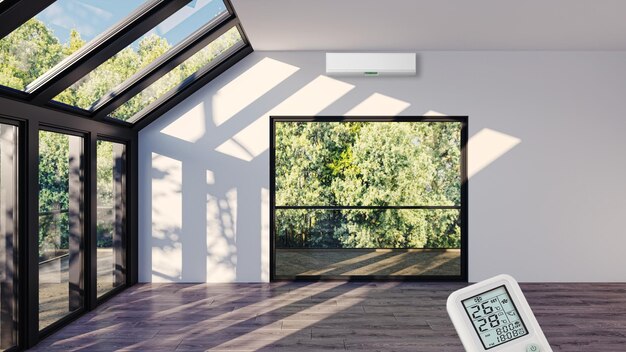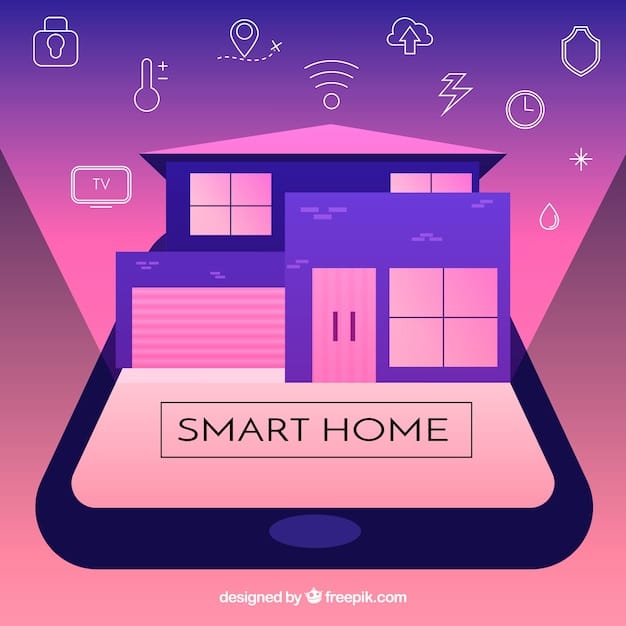Boost Energy Efficiency: Smart Home Tech in US Buildings

Smart home technologies offer significant potential for the US to improve energy efficiency in buildings by automating energy usage, optimizing heating and cooling, and providing real-time monitoring and control.
The United States faces a crucial challenge in reducing its carbon footprint and enhancing energy security. Improving energy efficiency in buildings is a key component of addressing this challenge, and smart home technologies offer a promising avenue for achieving significant progress.
Understanding the US Energy Efficiency Challenge in Buildings
Buildings in the US account for a substantial portion of the nation’s total energy consumption. This consumption includes electricity for lighting, powering appliances, heating, and cooling. Older buildings, in particular, often lack adequate insulation and efficient systems, leading to significant energy waste.
Improving energy efficiency not only reduces overall energy demand but also lowers utility bills for homeowners and businesses, while also contributing to a healthier planet. Smart home technologies can play a crucial role in tackling this challenge.

Why Buildings are Energy Hogs
Several factors contribute to the high energy consumption of buildings. These include:
- Poor Insulation: Inadequate insulation allows heat to escape in the winter and enter in the summer, forcing HVAC systems to work harder.
- Outdated HVAC Systems: Older heating, ventilation, and air conditioning systems are often inefficient compared to newer models.
- Inefficient Lighting: Traditional incandescent and fluorescent lighting consumes significantly more energy than LED lighting.
- Phantom Loads: Many electronics continue to draw power even when turned off, contributing to energy waste.
Addressing these issues requires a multifaceted approach, and smart home technologies can offer targeted solutions for each of these areas.
In conclusion, the potential for energy savings in US buildings is substantial, making energy efficiency a key national priority. Smart home technologies stand out as a vital component for sustainable energy management.
The Role of Smart Home Technologies in Energy Efficiency
Smart home technologies encompass a range of devices and systems that automate and optimize energy consumption in buildings. These technologies can be integrated into existing homes or incorporated into new construction projects, offering flexibility for various applications.
From smart thermostats to intelligent lighting systems, these tools are designed to reduce waste and promote a more sustainable approach to energy use.
Key Smart Home Technologies for Energy Savings
Here are some of the most promising smart home technologies for improving energy efficiency:
- Smart Thermostats: These devices learn your heating and cooling preferences and automatically adjust the temperature to optimize comfort and energy savings.
- Smart Lighting: Intelligent lighting systems allow you to control lighting levels, schedule on/off times, and even adjust the color temperature to match your circadian rhythm.
- Smart Plugs: These plugs enable you to remotely control and monitor the energy consumption of individual appliances and electronics.
- Energy Monitoring Systems: These systems provide real-time data on your energy usage, allowing you to identify areas where you can reduce consumption.
These technologies leverage data and automation to achieve energy conservation, transforming how buildings consume energy across the US.
The integration of smart home technologies presents considerable opportunities to enhance energy efficiency in buildings, marking a transition toward sustainable living within the US domestic and commercial spheres.

Benefits of Smart Home Technology for Energy Efficiency
The benefits of adopting smart home technologies for energy efficiency extend beyond simple cost savings. These technologies offer enhanced comfort, convenience, and a reduced environmental impact.
By providing real-time insights and automated control, these systems empower users to make more informed decisions about their energy consumption.
Quantifiable Advantages of Smart Homes
Some of the key benefits include:
- Reduced Energy Consumption: Studies have shown that smart thermostats can reduce heating and cooling costs by up to 20%.
- Lower Utility Bills: By optimizing energy consumption, smart home technologies can lead to significant savings on monthly utility bills.
- Improved Comfort: Automated temperature and lighting control can create a more comfortable living environment.
- Reduced Environmental Impact: Lowering energy consumption reduces greenhouse gas emissions and contributes to a more sustainable future.
These advantages underline the efficacy and value of equipping buildings with smart technology for enhanced energy management.
Incorporating smart home technologies enhances building energy efficiency, while also offering economic and ecological benefits that resonate nationwide.
Overcoming Barriers to Smart Home Technology Adoption
Despite the clear benefits, the widespread adoption of smart home technologies in the US faces several barriers. These include high upfront costs, concerns about data privacy, and a lack of consumer awareness.
Addressing these barriers requires targeted policies, incentives, and educational initiatives.
Addressing Key Challenges
Here are some strategies for overcoming these barriers:
- Incentives and Rebates: Government incentives and utility rebates can help to offset the upfront costs of smart home technologies.
- Data Privacy Regulations: Robust data privacy regulations can address consumer concerns about the collection and use of personal data by smart home devices.
- Educational Campaigns: Public awareness campaigns can educate consumers about the benefits of smart home technologies and how they can save energy and money.
Through focused action, these barriers can be dismantled, facilitating the proliferation of smart home technologies to achieve broader energy efficiency objectives.
Successfully navigating these challenges will encourage more Americans to embrace smart home technologies, driving energy efficiency across the nation’s building landscape.
Government Policies and Initiatives Supporting Smart Homes
Government policies and initiatives play a crucial role in promoting the adoption of smart home technologies and driving energy efficiency improvements in buildings.
These policies can include tax credits, grants, and building codes that incentivize the use of energy-efficient technologies.
Policy Frameworks for Energy Efficiency
Several key policy initiatives could significantly impact the energy efficiency of buildings:
- Tax Credits for Energy-Efficient Upgrades: Offering tax credits to homeowners who install smart thermostats, lighting, and other energy-efficient technologies.
- Building Codes that Mandate Smart Technology: Updating building codes to require the installation of smart home technologies in new construction projects.
- Grant Programs for Low-Income Households: Providing grants to help low-income households afford the upfront costs of smart home technologies.
These supportive measures are poised to accelerate the incorporation of smart home technologies into the US building sector.
The integration of effective government assistance is fundamental in positioning smart home technologies as dominant instruments for enhancing energy efficiency in constructions across the country.
The Future of Energy Efficiency with Smart Homes
The future of energy efficiency in US buildings is inextricably linked to the continued development and adoption of smart home technologies. As these technologies become more affordable and user-friendly, they are likely to become ubiquitous in homes and businesses across the country.
Moreover, advancements in artificial intelligence and machine learning will further enhance the ability of smart home systems to optimize energy consumption.
Trends Shaping the Future
Key trends to watch include:
- Increased Integration: Smart home systems will become more integrated with each other and with the grid, allowing for more seamless and efficient energy management.
- Advanced Analytics: AI-powered analytics will enable smart home systems to predict energy consumption patterns and optimize usage accordingly.
- Personalized Energy Solutions: Smart home systems will be tailored to individual needs and preferences, providing personalized energy-saving recommendations.
These innovative advancements ensure that smart home technologies will remain at the forefront of escalating energy efficiency within the US construction domain.
As smart home technologies evolve and become more sophisticated, they assure a future where buildings are not just structures, but dynamic entities optimized for energy conservation and sustainable living.
| Key Point | Brief Description |
|---|---|
| 💡 Smart Thermostats | Learns & adjusts temperature automatically, reducing heating/cooling costs by up to 20%. |
| 🔆 Smart Lighting | Controls lighting levels & schedules, using less energy than traditional bulbs. |
| 🔌 Smart Plugs | Remotely monitor & control appliance energy, preventing phantom loads. |
| 📊 Energy Monitoring | Provides real-time data on energy usage, helping identify reduction opportunities. |
Frequently Asked Questions
▼
The main benefits include reduced energy consumption, lower utility bills, improved comfort, and reduced environmental impact due to decreased greenhouse gas emissions.
▼
Smart thermostats learn your preferences and automatically adjust the temperature, preventing energy waste when you’re away or asleep, leading to efficient savings.
▼
The initial costs can vary, but government incentives and rebates can help offset upfront investments. Long-term utility bill savings typically outweigh installation expenses.
▼
Government policies support smart home tech through tax credits, grants, and building codes, incentivizing wider use for energy efficiency on a national scale.
▼
Security varies; robust data privacy regulations and consumer awareness are crucial. Choose devices with strong protection, updating software and using secure networks.
Conclusion
In conclusion, smart home technologies offer a powerful means of improving energy efficiency in US buildings. By addressing barriers to adoption, promoting supportive policies, and embracing technological advancements, the United States can leverage the full potential of smart homes to achieve its energy efficiency goals and create a more sustainable future.





